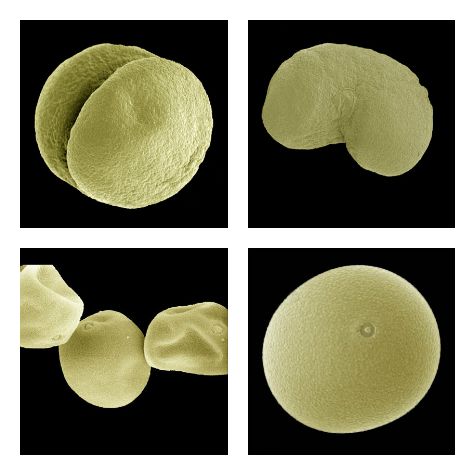
Like seeds, pollen loses most of its water during maturation, entering a state of suspended animation. This allows it to survive its journey from male to female organs of a flower, where it is rehydrated by sugary fluids secreted by the female organ, and springs into life again.
But rehydrating is a dangerous process, one that can kill the pollen grain before it can fertilize the egg if not properly controlled.
New research from the lab of Elizabeth Haswell, PhD, associate professor of biology in Arts & Sciences at Washington University in St. Louis, published Oct. 23, 2015, in the journal Science, shows how pollen survives the reanimation process. A specialized protein with ancient origins helps the hydrating pollen grain relieve excessive pressure and survive the stressful transition.
Too little — or too much — of this protein impairs pollen’s ability to fertilize the female egg, showing that the protein is a crucial part of reproductive success.
https://www.youtube.com/watch?v=qTyyuOHx0GE
Sensing pressure
Like all living things, plants must respond to forces in their environment in order to adapt and thrive. Sensing gravity, their roots grow down instead of up. Feeling strong winds, plants grow shorter and stockier. And sensing that the membranes that enclose their cells are stretched, they open pores to reduce potentially damaging pressure.
The pressure sensor and safety valve are combined in a single protein, named MSL8, which is a mechanosensitive ion channel. An ion channel is a small pore in the cell membrane that allows specific ions (charged atoms) to enter or leave the cell. It is not continuously open, however, but instead is gated, opening and closing in response to membrane stretch.
For years, scientists have known that bacteria use stretch-activated channels to relieve excessive internal pressure. When too much water rushes into the cell and stretches the membrane, like an inflating balloon, these channels open to keep the cell from bursting, acting as a kind of safety valve.
Researchers found evolutionary cousins of these proteins in plants more than 10- years ago, but it wasn’t clear just what they were doing. Plants and bacteria diverged billions of years ago — so what links the two still?
In many ways, a mature pollen grain resembles a bacterium: a single cell, all on its own, without support from its mother plant. So when an undergraduate in Haswell’s lab discovered that dry pollen missing MSL8 died when it took up water too quickly, Haswell realized that despite the evolutionary distance between them, pollen and bacteria both used stretch-activated channels as safety valves.
“The bacterial channel protects the bacteria from random environmental stress,” Haswell said. “In the pollen a related channel is also protecting the cell, but from stresses it must withstand in order to reproduce.”

After rehydrating, reanimated pollen grows a long tube to carry sperm cells to the waiting egg cell, something with no parallel in bacteria. Pollen missing MSL8 readily germinated this pollen tube — even better than pollen with the channel — but the tubes went on to burst, unable to control the pressure that powered their growth. The upshot was that pollen without MSL8 didn’t fertilize eggs as well.
Eric Hamilton, a fourth-year PhD candidate in the Plant and Microbial Biosciences program and the lead author of the paper, was surprised to find it was also difficult to propagate plants that produced high levels of MSL8. Investigating, he discovered that their pollen had a hard time germinating its pollen tube. Pollen with excess MSL8 couldn’t build up the pressure required to bust through the tough pollen cell wall. Unable to drive a pollen tube to an egg, it was infertile.
So it’s a Goldilocks situation: too little MSL8 and pollen bursts; too much, and it can’t power the growth required to reach the egg. Although pollen protects itself during hydration much as bacteria do, MSL8’s role in the pollen tube growth shows that plants have adapted this ancient channel to their unique needs.
“This study illustrates how important mechanical signals are in biology,” Haswell said. “They are not just stress signals from the environment, but also signals that are part of normal developmental processes. Mechanotransduction is important to every aspect of an organism’s life.”


